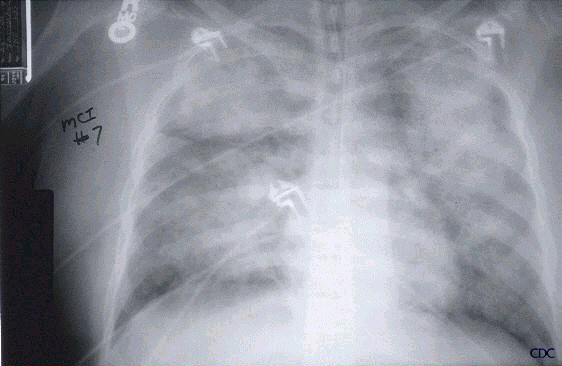Bubonic plague differential diagnosis: Difference between revisions
Jump to navigation
Jump to search
No edit summary |
|||
| Line 1: | Line 1: | ||
There are many diseases that resemble the basic [[signs]] and [[symptoms]] of bubonic plague. Since bubonic plague has the ability to kill the majority of a population, it is an extremely concerning diagnosis. It is very important to check for these other diseases before a final diagnosis of bubonic plague is made. There are many other [[bacterial]] [[infections]] that could be mistaken for the bubonic plague. | There are many diseases that resemble the basic [[signs]] and [[symptoms]] of bubonic plague. Since bubonic plague has the ability to kill the majority of a population, it is an extremely concerning diagnosis. It is very important to check for these other diseases before a final diagnosis of bubonic plague is made. There are many other [[bacterial]] [[infections]] that could be mistaken for the bubonic plague. | ||
==Differential diagnosis== | ==Differential diagnosis== | ||
===Bubonic plague=== | ===Bubonic plague=== | ||
*[[Streptococcal]] or [[staphylococcal]] [[adenitis]] (Staphylococcal | *[[Streptococcal]] or [[staphylococcal]] [[adenitis]] (Staphylococcal aureus, Staphylococcal pyogenes) | ||
**Purulent or inflamed [[lesion]] often noted [[distal]] to involved | **Purulent or inflamed [[lesion]] often noted [[distal]] to involved [[nodes]] (i.e., [[pustule]], infected traumatic lesion). | ||
**Involved nodes more likely to be fluctuant. | **Involved nodes more likely to be fluctuant. | ||
**Associated ascending [[lymphangitis]] or [[cellulitis]] may | **Associated ascending [[lymphangitis]] or [[cellulitis]] may be present (generally not seen with plague). | ||
*[[Tularemia]] (Francisella tularensis) | *[[Tularemia]] (Francisella tularensis) | ||
| Line 16: | Line 15: | ||
*[[Cat scratch fever]] (Bartonella henselae) | *[[Cat scratch fever]] (Bartonella henselae) | ||
**History of contact with cats; usually history of cat | **History of contact with cats; usually history of cat scratch. | ||
**Indolent clinical course; progresses over weeks. | **Indolent clinical course; progresses over weeks. | ||
**Primary lesion at site of scratch often present (small | **Primary lesion at site of scratch often present (small [[papule]], [[vesicle]]). | ||
**Systemic toxicity not present. | **Systemic toxicity not present. | ||
*[[Mycobacterial infection]], including [[scrofula]] | *[[Mycobacterial infection]], including [[scrofula]] (Mycobacterium tuberculosis and other Mycobacterium species) | ||
**With scrofula, [[adenitis]] occurs in [[cervical]] region. | **With scrofula, [[adenitis]] occurs in [[cervical]] region. | ||
**Usually [[painless]]. | **Usually [[painless]]. | ||
**Indolent clinical course. | **Indolent clinical course. | ||
**[[Infections]] with species other than M. tuberculosis | **[[Infections]] with species other than M. tuberculosis more likely to occur in [[immunocompromised]] patients. | ||
*[[Lymphogranuloma venereum]] (Chlamydia trachomatis) | *[[Lymphogranuloma venereum]] (Chlamydia trachomatis) | ||
| Line 31: | Line 30: | ||
**History of [[sexual]] exposure 10-30 days previously. | **History of [[sexual]] exposure 10-30 days previously. | ||
**Suppuration, fistula tracts common. | **Suppuration, fistula tracts common. | ||
**Although LGV [[buboes]] may be somewhat [[tender]], exquisite | **Although LGV [[buboes]] may be somewhat [[tender]], exquisite tenderness usually absent. | ||
**Although patients may appear ill ([[headache]], [[fever]], [[myalgias]]), | **Although patients may appear ill ([[headache]], [[fever]], [[myalgias]]), systemic [[toxicity]] not present. | ||
*[[Chancroid]] (Hemophilus ducreyi) | *[[Chancroid]] (Hemophilus ducreyi) | ||
| Line 42: | Line 41: | ||
**Herpes lesions present in genital area. | **Herpes lesions present in genital area. | ||
**Adenitis occurs in the inguinal region. | **Adenitis occurs in the inguinal region. | ||
**Although patients may be ill (fever, headache), severe | **Although patients may be ill (fever, headache), severe systemic toxicity not present. | ||
*Primary or secondary [[syphilis]] (Treponema pallidum) | *Primary or secondary [[syphilis]] (Treponema pallidum) | ||
| Line 51: | Line 50: | ||
*Strangulated inguinal [[hernias]] | *Strangulated inguinal [[hernias]] | ||
**Evidence of bowel involvement. | **Evidence of bowel involvement. | ||
==Chest X Ray== | ==Chest X Ray== | ||
Revision as of 20:35, 17 December 2012
There are many diseases that resemble the basic signs and symptoms of bubonic plague. Since bubonic plague has the ability to kill the majority of a population, it is an extremely concerning diagnosis. It is very important to check for these other diseases before a final diagnosis of bubonic plague is made. There are many other bacterial infections that could be mistaken for the bubonic plague.
Differential diagnosis
Bubonic plague
- Streptococcal or staphylococcal adenitis (Staphylococcal aureus, Staphylococcal pyogenes)
- Purulent or inflamed lesion often noted distal to involved nodes (i.e., pustule, infected traumatic lesion).
- Involved nodes more likely to be fluctuant.
- Associated ascending lymphangitis or cellulitis may be present (generally not seen with plague).
- Tularemia (Francisella tularensis)
- Cat scratch fever (Bartonella henselae)
- Mycobacterial infection, including scrofula (Mycobacterium tuberculosis and other Mycobacterium species)
- With scrofula, adenitis occurs in cervical region.
- Usually painless.
- Indolent clinical course.
- Infections with species other than M. tuberculosis more likely to occur in immunocompromised patients.
- Lymphogranuloma venereum (Chlamydia trachomatis)
- Chancroid (Hemophilus ducreyi)
- Adenitis occurs in the inguinal region.
- Ulcerative lesion present.
- Systemic symptoms uncommon; toxicity does not occur.
- Primary genital herpes
- Herpes lesions present in genital area.
- Adenitis occurs in the inguinal region.
- Although patients may be ill (fever, headache), severe systemic toxicity not present.
- Primary or secondary syphilis (Treponema pallidum)
- Enlarged lymph nodes in the inguinal region.
- Lymph nodes generally painless.
- Chancre may be noted with primary syphilis.
- Strangulated inguinal hernias
- Evidence of bowel involvement.
Chest X Ray
Some other infectious diseases can be differentiated by looking at chest x ray images. For example, SARS, Hantavirus syndrome, and Anthrax all need to be ruled out because they do present with some similar Symptoms. An example of a chest x ray for Hantavirus and Anthrax is shown.

